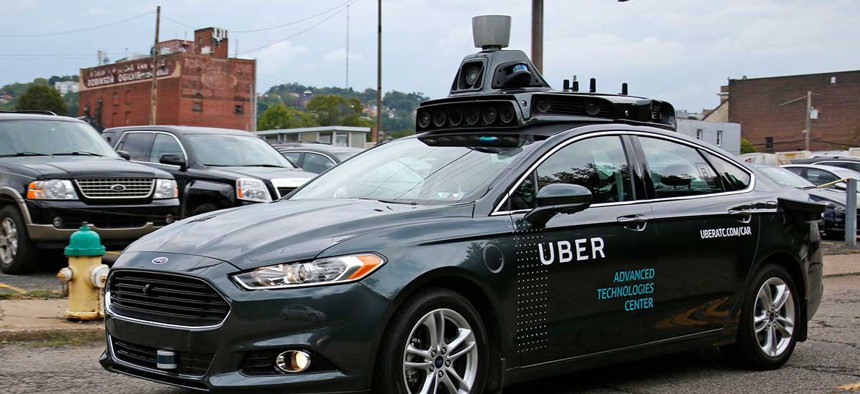The Transportation Department Officially Puts a Car In the Self-Driving Race
Federal regulators have released comprehensive guidelines for the emerging technology.
So far, the high-profile players in the race to put autonomous cars on the road have been the familiar corporate names, and perhaps their chosen test sites. Google’s been piloting its vehicles in California, Texas, Washington, and Arizona. Apple, too, is tinkering in Silicon Valley. Uber recently rolled out its first passenger-carrying fleet in Pittsburgh. Ford is testing out their robo-cars at University of Michigan’s “M-City” driving grounds, while Tesla’s already got “driver-assisted” Autopilot-equipped cars on highways all over the world.
Now U.S. Department of Transportation is officially inserting itself into this self-driving saga, issuing a long-awaited policy guidance on regulating the emerging technology nationwide. This amounts to a federal endorsement of full autonomy, and it’s a full-throated one, complete with an op-ed from President Barack Obama in the Pittsburgh Post-Gazette.
In the guidance, DOT aims to lay a foundation for the “safe testing and deployment” of autonomous vehicles. It includes a 15-point “Safety Assessment” to steer carmakers through the development phase, covering issues such as how vehicles are supposed to react if autonomous technology fails, and how the manufacturers plan to share the driving data their vehicles collect. It outlines a “model policy” for states, seeking to smooth the current patchwork of state laws governing robo-cars into something more consistent with national policy. And it discusses ways that the National Highway Traffic Safety Administration can apply current safety regulations to autonomous cars, as well as the potential for new standards and testing protocols that might be necessary as technology evolves.
That last section explicitly opens the possibility for new safety standards that many car-makers have been calling for, including certifications for vehicles that don’t have steering wheels or pedals. (That’s a more progressive stance than one issued earlier this year in draft rules by California’s DMV, which prohibited the use of driverless cars lacking such features.)
As was stressed by DOT officials, this guidance is just that: a guidance, not a statement of rule-making. As the result of years of closed-doors discussions with researchers, consumer groups, public officials, technology lobbyists, and carmakers (with a particularly warm relationship with Google), the DOT’s instructions struck a delicate balance; as the New York Times put it, they “signaled to motorists that automated vehicles would not be a Wild West where companies can try anything without oversight, but were also vague enough that automakers and technology companies would not fear overregulation.” It’s a “starting point,” according to the document itself, and accordingly:
DOT expects and intends this Policy and its guidance to be iterative, changing based on public comment; the experience of the agency, manufacturers, suppliers, consumers, and others; and further technological innovation. DOT intends to revise and refine the Policy periodically to reflect such experience, innovation, and public input.
The policy states that DOT expects to release new iterations of the guidance roughly annually, with the first official rules coming within the next few months.
For now, industry groups are widely hailing the policy. So are legal experts such as University of South Carolina law professor Bryant Walker Smith, who has closely followed the regulatory journey of self-driving vehicles. Today’s announcement is a sign that the DOT “can play a role not only in supervising but also in assisting this transportation transformation,” he writes in a blog post for the Center for Internet and Society at Stanford Law School. He continues:
I'm especially pleased to see the DOT's recommendation that these developers undertake -- and share -- a 15-point safety assessment. Given its limited resources and the speed of technological change, NHTSA cannot hope to come up with all the answers for automated driving in its many forms. But NHTSA can focus on asking the important questions. To that end, this safety assessment encourages developers to share what they are doing, why they think it is safe, and why they should be believed.
At a press event Tuesday afternoon, which included representatives from Mothers Against Drunk Driving, it was clear just how glowing an endorsement of self-driving vehicles this policy represents. Transportation Secretary Anthony Foxx called the new guidance the “most comprehensive” policy on self-driving cars the world has seen. “There has never been a moment like this, where we can build a culture of safety as a new technology emerges that harnesses the potential to save even more lives.”
It’s also an unusually forward-thinking move for the federal agency, Foxx admitted: “We tend to handle safety issues like referees—we only throw a flag after a violation has occurred. Here, we’re trying to get in at the ground floor.”



